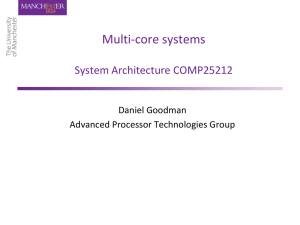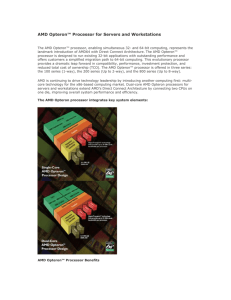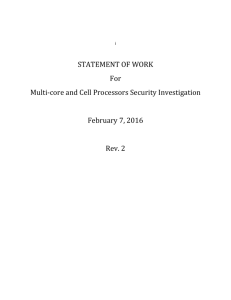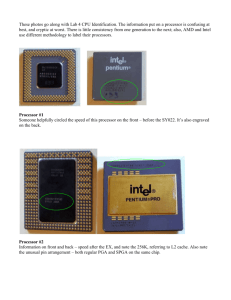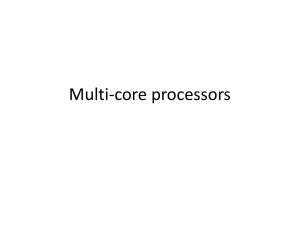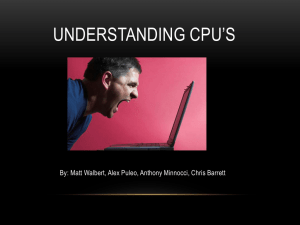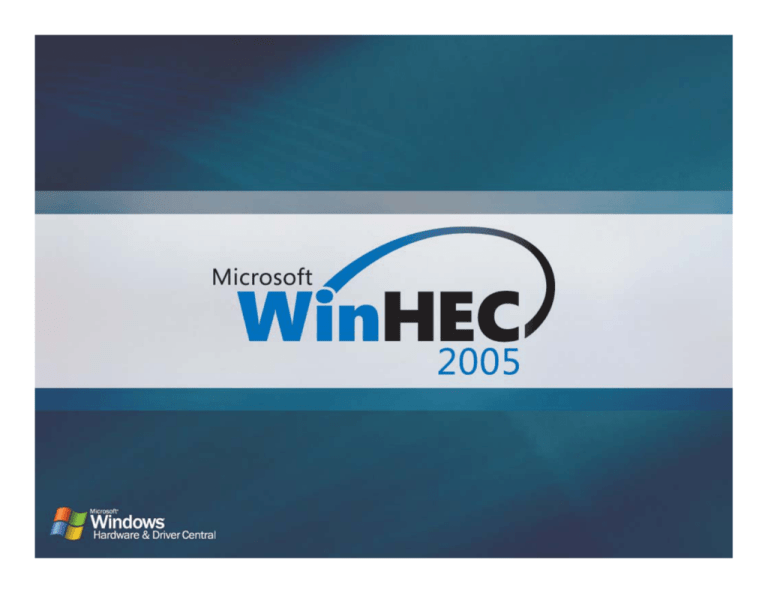
Multi-Core Processor Technology –
Maximizing CPU Performance in a
Power-Constrained World
Paul Teich
Business Strategy
CPG Server/Workstation
paul.teich@amd.com
AMD
The Issues
Silicon designers can choose a variety of
methods to increase processor performance
Commercial end-customers are demanding:
More capable systems with more capable processors
That new systems stay within their existing
power/thermal infrastructure
Processor frequency and power consumption
seem to be scaling in lockstep
How can the industry-standard PC and Server
industries stay on our historic performance curve
without burning a hole in our motherboards?
This session is not about process technology…
Session Outline
Definition – What is a processor?
Core Design
System Architecture
Manufacturing, Power, and Thermals
Multi-Core Processor Architecture
Performance Impacts
What is a Processor?
A single chip package that fits in a socket
≥1 cores (not much point in <1 core…)
Cores can have functional units, cache, etc. associated
with them, just as today
Cores can be fast or slow, just as today
Shared resources
More cache
Other integration – northbridge, memory controllers,
high-speed serial links, etc.
One system interface no matter how many cores
Number of signal pins doesn’t scale with number of
cores
A Representative Multi-Core Processor
Dual-core AMD
Opteron™ processor
is 199mm2 in 90nm
Single-core AMD
Opteron processor is
193mm2 in 130nm
Multi-Core Processor Architecture
Core Design
Frequency
Is only as good as the rest of the core architecture
AMD Opteron
processor core
architecture
Branch
Prediction
Fetch
L1
Icache
64KB
Scan/Align/Decode
Microcode Engine
Fastpath
µops
L1
Dcache
64KB
Instruction Control Unit (72 entries)
Int Decode & Rename
44-entry
Load/Store
Queue
Res
Res
Res
AGU
AGU
AGU
ALU
ALU
ALU
MULT
FP Decode & Rename
36-entry FP scheduler
FADD
FMUL
FMISC
Core Design
Functional units
Superscalar is known territory
Diminishing returns for adding more functional blocks
Alternatives like VLIW have been considered and
rejected by the market
Single-threaded architectural performance is pegged
Data paths
Increasing bandwidth between functional units in a core
makes a difference
Such as comprehensive 64-bit design, but then where to?
Core Design
Pipeline
Deeper pipeline buys frequency at expense of
increased cache miss penalty and lower instructions
per clock
Shallow pipeline gives better instructions per clock at
the expense of frequency scaling
Max frequency per core requires deeper pipelines
Industry converging on middle ground…9 to 11 stages
Successful RISC CPUs are in the same range
Cache
Cache size buys performance at expense of die size,
it’s a direct hit to manufacturing cost
Deep pipeline cache miss penalties are reduced by
larger caches
Not always the best match for shallow pipeline cores,
as cache misses penalties are not as steep
Manufacturing
Moore’s Law isn’t dead, more transistors for
everyone!
But…it doesn’t really mention scaling transistor power
Chemistry and physics at nano-scale
Stretching materials science
Voltage doesn’t scale yet
Transistor leakage current is increasing
As manufacturing economies and frequency
increase, power consumption is increasing
disproportionately
There are no process or architectural quick-fixes
Static Current vs. Frequency
Non-linear as processors approach max frequency
Static Current
15
Very High Leakage
and Power
Embedded
Parts
Fast, High
Power
Fast, Low
Power
0
1.0
Frequency
1.5
Power vs. Frequency
Power Consumption
In AMD’s process for 200MHz frequency steps, two
steps back on frequency cuts power consumption by
half…or lets you put twice the transistors on the die
for the same power consumption as top frequency…
2
1.5
1
0.5
n-4
n-3
n-2
n-1
n
Frequency
(Gross relative numbers summarized from a mountain of real data)
Thermal Density Decreases
Hot spots
Twice as many as in single-core
Farther apart than in single-core
With freq delta, cooler than in single-core
ΘCA same for single-core at n and dual-core at n-2
Larger die spreads heat more evenly in package
Use identical heat sink, slightly better cooling with dual-core
Works for this processor generation and next, ΘCA changes over major
generations
Thermal diode accuracy becomes an issue with dual-core…
Multi-Core Processor Architecture
Why integrate?
Most functions are really small compared to the cores
and cache
All integrated logic runs at core frequency regardless of
I/O speeds
What to integrate?
Northbridge crossbar switch is key to integrating
anything else
Memory controller to reduce memory latency and
further reduce the need for cache
High-speed serial links for system I/O
What not to integrate?
Most southbridge functions
Graphics
AMD Opteron Processor Integrated Northbridge
CPU 0
Data
CPU 1
Data
CPU 0
Probes
CPU 1
CPU 0
Probes Requests
CPU 1
Requests
CPU 0
Int
CPU 1
Int
System
Request
Interface
(SRI)
Advanced
Priority
Interrupt
Controller
(APIC)
Crossbar
(XBAR)
Memory
Controller
(MCT)
64-bit Data
64-bit
Command/Address
DRAM
Controller
(DCT)
16-bit
Data/Command/Address
HyperTransport
HyperTransport™
HyperTransport
Link 1
Link 0
Link 2
RAS/CAS/Cntl
DRAM
Data
Multi-Core: Where Processor and System Collide
Scales performance
Dedicated resources for two simultaneous threads
Multiple cores will contend for memory and I/O
bandwidth
Northbridge is the bottleneck
Integrating northbridge eliminates most of bottleneck
Cores, cache and northbridge must be balanced for
optimal performance
More aggregate performance for:
Multi-threaded apps
Transactions – many instances of same app
Multi-tasking
Thread scheduling handled by OS
BIOS notifies Windows of thread execution resources
Early Benchmark Estimates
Decoder
Memory, disks, network, etc.
Early dual-core validation
system used, different
motherboards
163
2P/4C
2P/2C
100
% Comparison to Base 2P/2C
OLTP Workload
244
4P/8C
Platforms
Identical system configs
184
4P/4C
Frequencies
Single-core = 2.4GHz
Dual-core = 2.0GHz
308
4P/8C
Platforms
2P/2C – 2 proc. single-core
4P/4C – 4 proc. single-core
2P/4C – 2 proc. dual-core
4P/8C – 4 proc. dual-core
SPECint_rate2000 Peak Win SP1
165
4P/4C
148
2P/4C
2P/2C
100
% Comparison to Base 2P/2C
SPEC and the benchmark name SPECint are registered
trademarks of the Standard Performance Evaluation Corporation.
SPEC scores for AMD Opteron Model 270 and 870 based
systems are estimated.
Call To Action
Most application software doesn’t need to do
anything to benefit from dual-core
Be aware that, for a processor within a given
power envelope:
Fewer cores will clock faster than more cores
Single-threaded performance-sensitive applications
More cores will out-perform fewer cores for
Multi-threaded applications
Multi-tasking response times
Transaction processing
Processor architecture impacts multi-core
performance
Process technology is only the ante
Integration enables a balanced high-performance
architecture
Additional Resources
WinHEC Presentations:
x86 Everywhere, Chris Herring, AMD
Web Resources:
AMD http://www.amd.com/
AMD Multi-Core: http://www.amd.com/multicore
AMD Opteron™ Processor Tech Docs:
http://www.amd.com/usen/Processors/TechnicalResources/0,,30_182_739_9003,
00.html
AMD Multi-Core White Paper: http://www.amd.com/usen/assets/content_type/DownloadableAssets/MC_Whitep
aper_vFINAL.pdf
HyperTransport™ Consortium:
http://www.hypertransport.org/
© 2005 Microsoft Corporation. All rights reserved.
This presentation is for informational purposes only. Microsoft makes no warranties, express or implied, in this summary.

